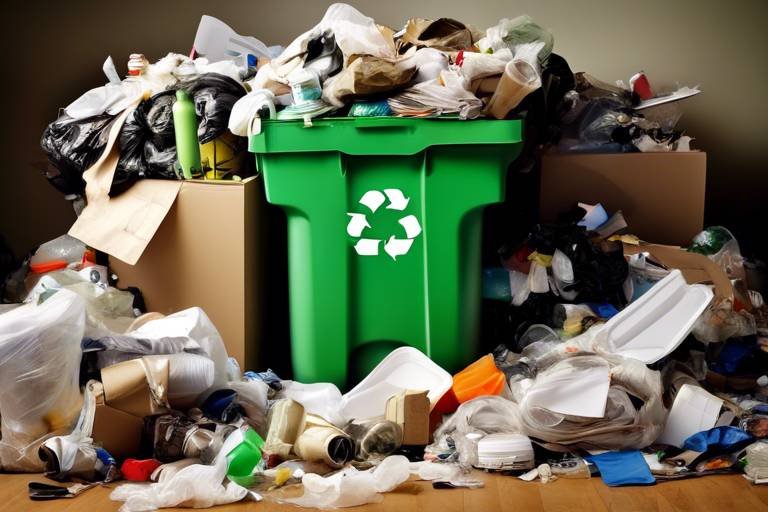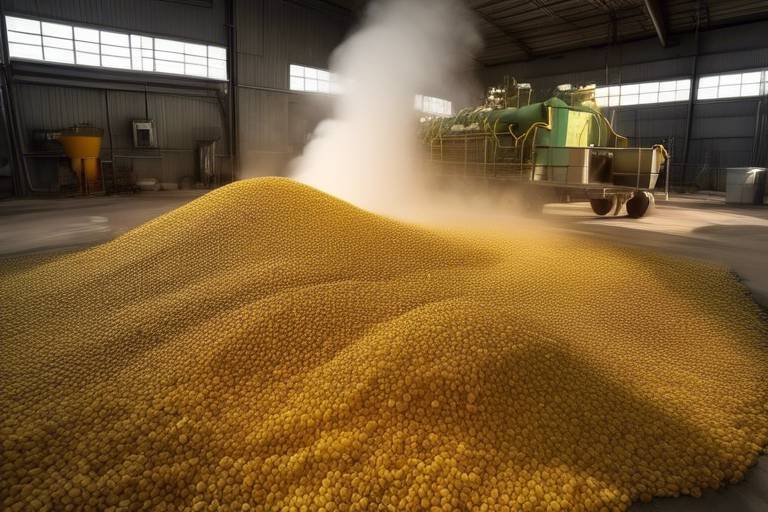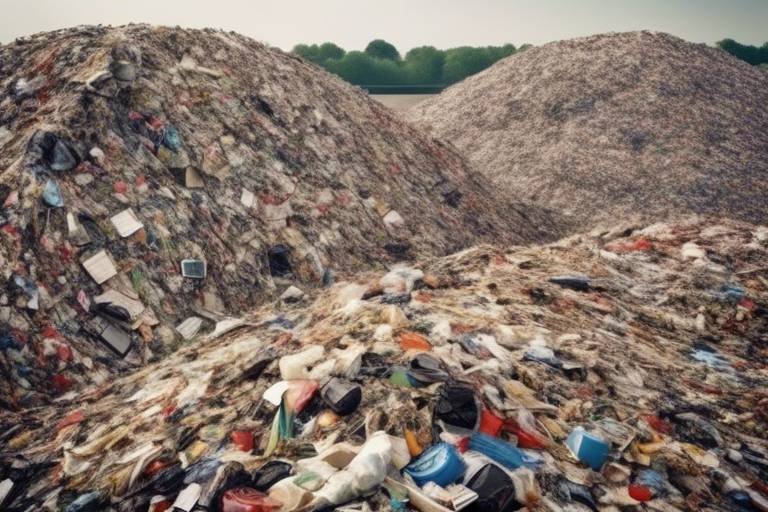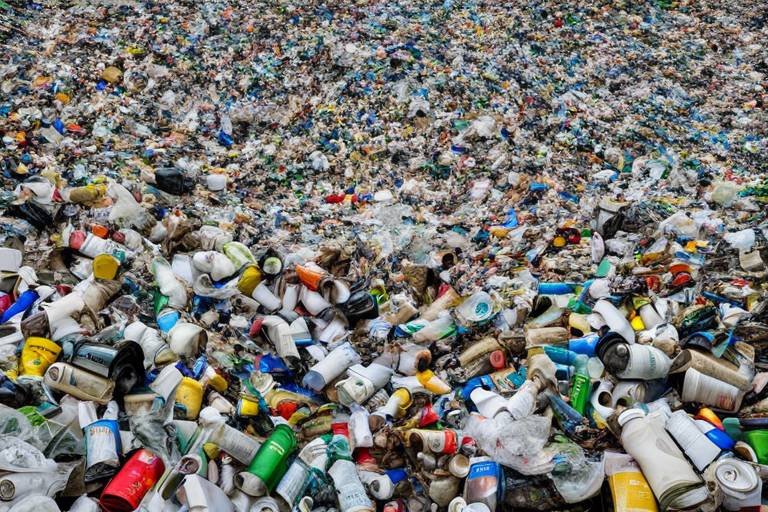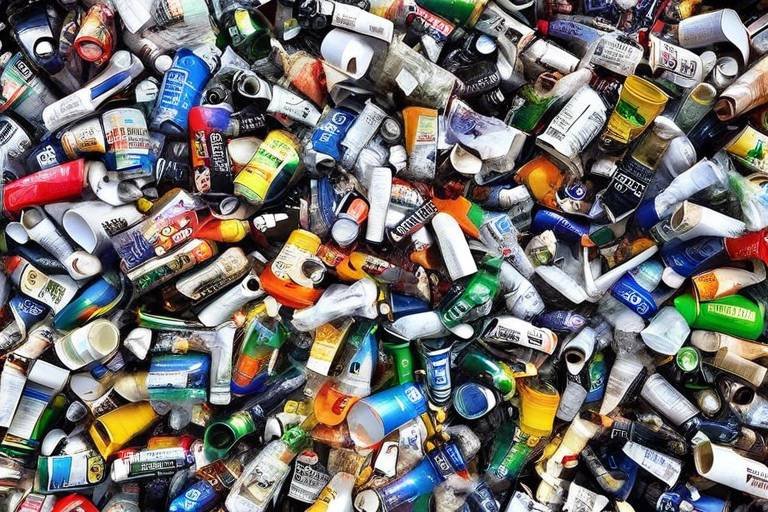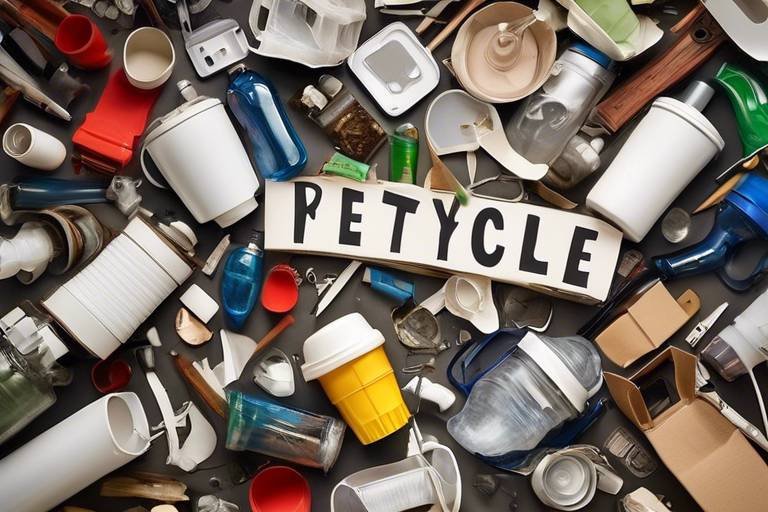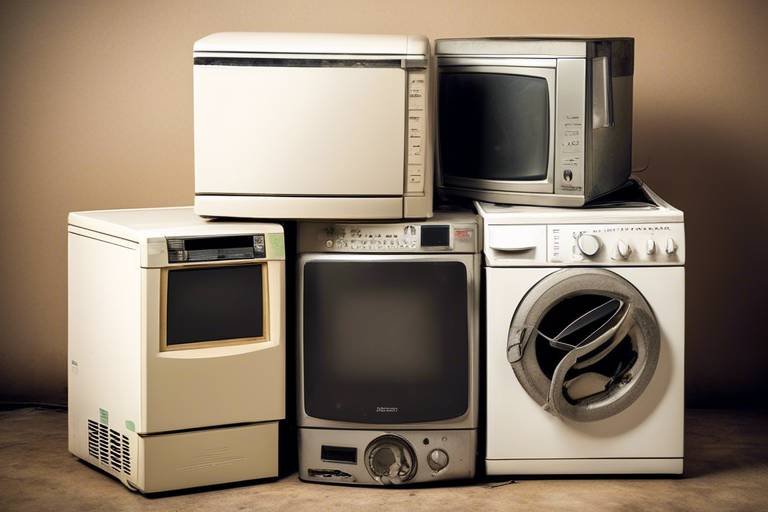The Correlation Between Economic Growth and Waste Generation
In today's rapidly evolving world, the intricate relationship between economic growth and waste generation has become more apparent than ever. As economies expand and production ramps up, the byproduct of this growth—waste—also increases significantly. This phenomenon raises pressing questions about sustainability and the future of our planet. Are we, as a society, prepared to handle the consequences of our consumer-driven lifestyles? The journey of understanding this correlation is not just an academic exercise; it's a vital exploration of how our choices today will shape the world of tomorrow.
To illustrate this connection, let's consider a simple analogy: think of economic growth as a balloon being inflated. As the balloon expands, it represents the increase in goods and services produced. However, as the balloon grows, it also creates tension—this tension symbolizes the waste generated as a direct result of that growth. If we don’t find a way to manage that tension, the balloon could burst, leading to catastrophic consequences for our environment and society.
The statistics are staggering. According to the World Bank, global waste is expected to increase by 70% by 2050 if current trends continue. This dramatic rise is driven largely by urbanization and industrialization, which are often seen as hallmarks of progress. However, with increased production comes a corresponding increase in waste, posing a significant challenge for waste management systems worldwide.
As we delve deeper into this topic, it becomes clear that understanding the drivers of economic growth is crucial. Factors such as technological advancements, population growth, and consumer behavior all play pivotal roles in shaping waste generation patterns. Moreover, the implications of unchecked waste output extend beyond just environmental degradation; they also encompass social and economic ramifications that affect communities globally.
In the following sections, we will explore the nuances of this relationship, examining how urbanization and industrialization contribute to rising waste levels, the environmental consequences of our actions, and ultimately, the sustainable solutions we can implement to mitigate these challenges. The path forward is not just about economic growth; it is about finding a balance that allows us to thrive without compromising the health of our planet.
- What is the main cause of increased waste generation? The primary cause of increased waste generation is the rise in production and consumption driven by economic growth, urbanization, and industrialization.
- How does economic growth affect the environment? Economic growth often leads to higher waste output, which can result in pollution, resource depletion, and significant environmental degradation.
- What are some sustainable practices to reduce waste? Sustainable practices include recycling, composting, waste-to-energy technologies, and implementing policies that promote responsible consumption.
- Why is it important to address waste generation? Addressing waste generation is crucial for maintaining environmental health, ensuring resource availability, and improving public health and quality of life.

Understanding Economic Growth
Economic growth is a term that gets tossed around a lot, but what does it really mean? At its core, economic growth refers to the increase in the production of goods and services in an economy over a period of time. This growth is often measured by the Gross Domestic Product (GDP), which gives us a snapshot of how well an economy is performing. Think of GDP as the economic report card—if the grades are going up, it usually signals that the economy is doing well. But just like in school, not all grades tell the full story.
The drivers of economic growth can be quite diverse. They include factors such as technological advancements, increased consumer spending, and government policies that encourage investment. For instance, when a new technology emerges, it can create entire industries overnight, leading to job creation and increased production. However, this rapid growth can also lead to some unintended consequences, particularly in terms of waste generation. As more goods are produced, more resources are consumed, and inevitably, more waste is generated.
To illustrate this point, let’s consider a few key elements that contribute to economic growth:
- Investment in Infrastructure: Roads, bridges, and public transportation systems facilitate trade and movement, boosting economic activities.
- Consumer Confidence: When people feel secure in their jobs, they spend more, which in turn stimulates production.
- Global Trade: Engaging in international markets opens up new opportunities for growth and innovation.
While economic growth can lead to improved living standards, it’s essential to recognize that it comes with a price. Increased production often means increased consumption, which can lead to a surge in waste generation. As economies expand, the demand for goods rises, and so does the amount of waste produced. This creates a complex relationship between economic growth and sustainability.
In summary, understanding economic growth is crucial for grasping its broader implications on society and the environment. As we continue to push for greater production and consumption, we must also consider how these activities impact our planet. The challenge lies in finding a balance between fostering economic growth and ensuring that our waste generation does not spiral out of control, threatening our sustainability efforts.

Waste Generation Trends
In today's rapidly evolving world, the relationship between economic growth and waste generation is becoming increasingly evident. As nations develop and urbanize, the amount of waste produced escalates at an alarming rate. This phenomenon can be attributed to several factors, including population growth, increased consumption patterns, and the rise of disposable culture. According to recent studies, global waste generation is expected to increase by 70% by 2050 if current trends continue. This statistic alone highlights the urgent need for sustainable waste management practices.
One of the primary drivers of waste generation is urbanization. As people flock to cities in search of better opportunities, urban areas expand, leading to higher demand for goods and services. This surge in consumption inevitably results in more waste. In fact, urban areas currently account for over 70% of global waste, a figure that is projected to rise as more individuals choose city living. The challenge lies not only in managing this waste but also in understanding the types of waste being generated, which can vary significantly from one region to another.
Industrialization further compounds the issue of waste generation. Manufacturing processes are notorious for producing large quantities of waste, including hazardous materials that can have detrimental effects on the environment. For instance, industries such as construction, mining, and food processing are among the largest contributors to waste output. A recent report indicated that industrial waste alone accounts for approximately 50% of total waste generated globally. This highlights the critical need for industries to adopt more sustainable practices to mitigate their environmental impact.
| Type of Waste | Percentage of Total Waste |
|---|---|
| Municipal Solid Waste | 30% |
| Industrial Waste | 50% |
| Agricultural Waste | 20% |
The implications of these trends are far-reaching. Increased waste generation not only contributes to environmental degradation but also places a significant burden on waste management systems. Many cities struggle to keep up with the growing volumes of waste, leading to overflowing landfills and increased pollution levels. This situation raises critical questions about how we can balance economic growth with responsible waste management.
Moreover, the social implications of rising waste levels cannot be overlooked. Communities that are disproportionately affected by waste generation often face public health risks, decreased quality of life, and economic challenges. For instance, areas near landfills may experience higher rates of respiratory diseases and other health issues, highlighting the need for equitable waste management solutions.
In summary, understanding waste generation trends is crucial for developing effective strategies to address the challenges posed by economic growth. As we continue to urbanize and industrialize, it is imperative that we adopt sustainable practices that not only reduce waste but also promote a healthier environment for future generations.

The Role of Urbanization
Urbanization is more than just a buzzword; it’s a phenomenon that shapes our world in profound ways. As people flock to cities, drawn by the promise of jobs, education, and a better quality of life, the dynamics of consumption and waste generation shift dramatically. Think of urbanization as a double-edged sword: on one side, it drives economic growth and innovation, while on the other, it significantly increases the volume of waste produced. With more people living in close quarters, the demand for goods skyrockets, and so does the waste that comes from their production and consumption.
In urban areas, the relationship between population density and waste generation becomes particularly evident. For instance, cities often produce waste at a rate that far exceeds their rural counterparts. According to recent studies, urban centers can generate up to three times more waste per capita compared to rural regions. This is largely due to the lifestyle changes that accompany urban living, where convenience often trumps sustainability. As people opt for take-out meals, packaged goods, and disposable products, waste accumulates at an alarming rate.
Moreover, urbanization is closely tied to industrialization, as cities become hubs for manufacturing and services. The influx of industries not only creates jobs but also contributes significantly to waste output. Factories churn out products, but they also generate a variety of byproducts and waste materials that need to be managed. This creates a complex web of challenges for city planners and waste management authorities, who must find ways to cope with the increasing volumes of refuse.
To illustrate the impact of urbanization on waste generation, consider the following factors:
- Increased Consumption: Urban dwellers tend to consume more goods and services, leading to higher waste production.
- Convenience Culture: The preference for convenience often results in more single-use products, contributing to larger waste streams.
- Population Density: Higher population density means more waste generated in a smaller area, complicating waste management efforts.
As cities continue to grow, the strain on waste management systems becomes increasingly apparent. Many urban areas struggle to keep up with the waste they generate, leading to overflowing landfills and pollution. The need for robust waste management infrastructure is crucial. Cities must invest in recycling programs, composting facilities, and waste-to-energy technologies to address the growing waste crisis effectively.
In conclusion, urbanization plays a pivotal role in waste generation, creating both challenges and opportunities for sustainability. By understanding this relationship, we can work towards solutions that not only support economic growth but also protect our environment for future generations.

Impact on Infrastructure
The rapid expansion of urban areas due to economic growth brings with it a multitude of challenges, particularly in the realm of waste management infrastructure. As cities grow, they attract a larger population and more industries, which in turn leads to increased waste generation. This surge in waste demands a corresponding enhancement in waste management systems, yet many urban areas struggle to keep pace. Imagine a bustling city where the streets are lined with new businesses and residential buildings, but the waste disposal facilities are still operating at capacity. It’s a scenario that many metropolitan areas face today.
One of the primary challenges is the inadequate capacity of existing waste management systems. Many cities were designed decades ago, and their infrastructure has not evolved to handle the current waste volumes. As a result, we see overflowing landfills, illegal dumping, and even waste littering public spaces. This situation not only affects the aesthetics of a city but also poses serious public health risks.
Moreover, the financial burden of upgrading waste management infrastructure can be substantial. Cities must allocate funds for new facilities, technologies, and personnel. This often means diverting resources from other critical areas such as education or transportation. For instance, consider the following table that illustrates the potential costs associated with upgrading waste management systems:
| Infrastructure Component | Estimated Cost (in millions) |
|---|---|
| New Landfill Development | $5 - $15 |
| Recycling Facility Upgrade | $2 - $10 |
| Composting Site Establishment | $1 - $5 |
| Waste-to-Energy Plant Construction | $20 - $50 |
In addition to financial constraints, cities also face logistical challenges. Collecting and processing waste efficiently requires a well-coordinated system of trucks, routes, and schedules. With increased waste generation, the demand for collection services rises, often leading to delays and inefficiencies. Picture a garbage truck struggling to navigate through congested city streets, only to find that the landfill is already at capacity. This scenario not only frustrates residents but also creates a backlog of waste that can lead to unsanitary conditions.
Furthermore, the environmental impact of inadequate waste management infrastructure cannot be overlooked. Overflowing landfills can lead to leachate, a toxic liquid that seeps into the ground and contaminates local water sources. This not only poses a risk to the environment but also impacts the health of communities living nearby. In essence, the failure to invest in robust waste management infrastructure can create a vicious cycle of pollution and public health crises.
Ultimately, addressing the impact of economic growth on waste management infrastructure requires a multifaceted approach. This includes not only upgrading existing systems but also embracing innovative technologies and practices. For instance, cities could implement smart waste management solutions that utilize sensors and data analytics to optimize collection routes and schedules. By doing so, they can minimize costs and reduce their environmental footprint.
In conclusion, the relationship between economic growth and waste generation has profound implications for urban infrastructure. As cities expand and waste levels rise, the need for effective waste management systems becomes increasingly critical. Without adequate investment and innovation, urban areas may find themselves overwhelmed by the very growth that fuels their economies.

Social Implications
The surge in waste generation due to economic growth brings with it a myriad of that cannot be overlooked. As cities expand and industries ramp up production, the sheer volume of waste created poses significant challenges to public health and community well-being. Imagine living in a bustling city, where the streets are lined with overflowing bins, and the air is thick with the smell of garbage. This is not just an inconvenience; it is a serious threat to the quality of life for residents.
One of the most pressing issues is the impact of waste on public health. Increased waste can lead to unsanitary conditions, which in turn foster the spread of diseases. For instance, improper waste disposal can attract pests such as rats and mosquitoes, which are known carriers of various illnesses. Moreover, the accumulation of waste can contaminate local water supplies, exposing communities to harmful pollutants. The question arises: how can we ensure that our health is not compromised by the very progress that fuels our economy?
Beyond health concerns, the social fabric of communities is also affected. High levels of waste can lead to a decline in neighborhood aesthetics, making areas less appealing to live in. This can result in decreased property values and a sense of community pride. Furthermore, the burden of waste management often falls disproportionately on lower-income neighborhoods, exacerbating existing inequalities. Residents in these areas may find themselves living near landfills or incinerators, facing not only health risks but also a diminished quality of life. It’s a stark reminder that while economic growth can lift many, it can also leave others behind.
To better understand the social implications of waste generation, consider the following factors:
- Public Health Risks: Increased waste leads to health hazards, including the spread of diseases.
- Environmental Justice: Lower-income communities often bear the brunt of waste management issues.
- Community Aesthetics: Overflowing waste can make neighborhoods less attractive, affecting property values.
Addressing these social implications requires a collective effort from governments, businesses, and communities. Engaging residents in waste management initiatives can foster a sense of ownership and responsibility. For example, community clean-up events not only help reduce waste but also strengthen neighborhood bonds. As we navigate the complexities of economic growth and waste generation, it’s crucial to keep the conversation going about how we can create a more sustainable and equitable future for all.
Q1: What are the main social implications of increased waste generation?
A1: Increased waste generation can lead to public health risks, environmental justice issues, and a decline in community aesthetics, ultimately affecting the quality of life for residents.
Q2: How does waste management impact lower-income communities?
A2: Lower-income communities often face greater exposure to waste management issues, such as living near landfills or incinerators, which can exacerbate health risks and diminish their quality of life.
Q3: What can communities do to mitigate the effects of waste generation?
A3: Communities can engage in initiatives like clean-up events, recycling programs, and educational campaigns to promote responsible waste management and foster a sense of community pride.

Industrialization and Waste
Industrialization has been a driving force behind economic growth for centuries, but it comes with a hefty price tag in terms of waste generation. As factories churn out products to meet the ever-growing demands of consumers, they also produce a staggering amount of waste. This waste isn't just a byproduct; it's a significant environmental concern that can no longer be ignored. The manufacturing processes involved in industrialization often lead to the creation of various types of waste, including solid waste, hazardous waste, and emissions that contribute to air and water pollution.
Let's break down the types of waste generated during industrial processes:
- Solid Waste: This includes scraps, defective products, and packaging materials. Often, these materials end up in landfills, contributing to the growing waste crisis.
- Hazardous Waste: Many industries produce waste that is toxic or harmful to the environment and human health. This includes chemicals, heavy metals, and other dangerous substances that require special handling and disposal methods.
- Emissions: Factories emit pollutants into the air and water, which can lead to severe environmental degradation. These emissions can include greenhouse gases, particulate matter, and other harmful substances that affect air quality and contribute to climate change.
The environmental impacts of industrial waste are profound. For instance, the improper disposal of hazardous waste can lead to soil and water contamination, posing serious risks to local ecosystems and communities. Moreover, the accumulation of solid waste in landfills not only takes up valuable land but also contributes to greenhouse gas emissions as organic materials decompose. It's a vicious cycle that underscores the urgent need for sustainable practices in industrial operations.
Interestingly, the relationship between industrialization and waste is not merely linear; it's complex and multifaceted. As industries scale up production, the demand for raw materials increases, leading to more resource extraction and, consequently, more waste. This cycle can create a paradox where the very growth that fuels economies also threatens their sustainability. To illustrate this point, consider the following table that outlines the relationship between industrial output and waste generation:
| Year | Industrial Output (in billions) | Waste Generated (in millions of tons) |
|---|---|---|
| 2010 | 50 | 20 |
| 2015 | 70 | 30 |
| 2020 | 90 | 45 |
This table indicates a clear trend: as industrial output increases, so does waste generation. The challenge lies in breaking this cycle. Industries must adopt more sustainable practices to minimize waste, such as implementing efficient production techniques, investing in cleaner technologies, and prioritizing recycling and waste management initiatives. By doing so, they can not only reduce their environmental footprint but also enhance their long-term viability in a world that increasingly values sustainability.
In conclusion, while industrialization is essential for economic growth, it is equally crucial to address the waste it generates. The future of our planet depends on finding a balance between production and sustainability. As consumers, businesses, and governments work together to tackle this issue, we can pave the way for a more sustainable industrial landscape that benefits both the economy and the environment.
- What is industrialization? Industrialization refers to the process of transforming an economy from primarily agricultural to one based on the manufacturing of goods.
- How does industrialization contribute to waste generation? As industries produce more goods, they generate waste in the form of solid, hazardous, and emissions, which can harm the environment.
- What are some sustainable practices for industries? Sustainable practices include reducing waste, recycling materials, using cleaner technologies, and improving resource efficiency.

Environmental Consequences
The intricate relationship between economic growth and waste generation leads to profound that cannot be ignored. As economies expand, the demand for goods and services escalates, resulting in an increase in waste output. This surge in waste not only burdens local ecosystems but also contributes to global environmental issues. For instance, the sheer volume of waste generated can lead to significant pollution of air, water, and soil, which poses serious threats to biodiversity and human health.
One of the most alarming aspects of waste generation is its direct link to pollution. When waste is improperly managed, it can result in the leaching of harmful substances into the environment. This can lead to:
- Air Pollution: Emissions from waste incineration and landfills release toxic gases, contributing to respiratory problems and climate change.
- Water Pollution: Runoff from landfills can contaminate local water sources, affecting both aquatic life and human communities.
- Soil Degradation: Hazardous waste can deteriorate soil quality, making it less fertile and disrupting local ecosystems.
Moreover, the environmental consequences extend beyond immediate pollution. The accumulation of waste leads to ecosystem damage, impacting flora and fauna. For example, plastic waste in oceans not only harms marine animals but also disrupts entire food chains. The effects are cumulative and can lead to long-term ecological imbalances. As species struggle to adapt to polluted environments, biodiversity suffers, diminishing the resilience of ecosystems.
Additionally, the relentless extraction of resources to fuel economic growth results in resource depletion. The more we consume, the more we exploit natural resources, leading to a vicious cycle of degradation. This depletion affects not just the current generation but also future ones, as essential resources like clean water, fertile land, and biodiversity become scarcer. The long-term consequences of unsustainable consumption patterns are dire, prompting a pressing need for a shift towards more sustainable practices.
In conclusion, the environmental consequences of increased waste generation driven by economic growth are far-reaching. They encompass pollution, ecosystem damage, and resource depletion, all of which threaten the delicate balance of our planet. Addressing these issues requires urgent action and a commitment to sustainable practices that prioritize both economic development and environmental health.
- What are the main causes of waste generation? Waste generation is primarily caused by increased production and consumption patterns associated with economic growth, urbanization, and industrialization.
- How does waste impact the environment? Waste impacts the environment through pollution of air, water, and soil, leading to health issues and ecosystem damage.
- What can be done to reduce waste? Implementing waste reduction strategies such as recycling, composting, and promoting responsible consumption can significantly decrease waste output.

Pollution and Ecosystem Damage
As the link between economic growth and waste generation becomes increasingly evident, the consequences of this relationship manifest in various forms of pollution and damage to ecosystems. The more we produce and consume, the more waste we generate, which in turn leads to a greater environmental footprint. This cycle creates a storm of challenges, not just for our surroundings but for the very fabric of life on Earth. Think of it like a balloon: as we pump in more air (or in this case, resources), the balloon expands, but eventually, it can only stretch so far before it bursts. The resulting pollution from waste can be categorized into several types, each with its own detrimental effects on our ecosystems.
One of the most concerning types of pollution is water pollution. When waste is improperly disposed of, it often ends up in our rivers, lakes, and oceans, leading to contamination of water sources that many communities rely on for drinking and agriculture. This not only affects human health but also disrupts aquatic ecosystems. For instance, toxic substances can lead to the death of fish and other marine life, diminishing biodiversity and altering food chains.
Another significant contributor to ecosystem damage is air pollution. The burning of waste releases harmful gases and particulate matter into the atmosphere, which can lead to respiratory diseases in humans and animals alike. Moreover, these pollutants can contribute to climate change by increasing greenhouse gas concentrations. The relationship between air quality and economic activities is cyclical; as industries grow, so does the demand for energy, often sourced from fossil fuels, exacerbating air pollution.
Soil pollution is yet another critical issue. When waste is dumped in landfills or disposed of improperly, hazardous chemicals can leach into the ground, affecting soil health and fertility. This not only impacts agriculture but also disrupts the organisms that play vital roles in soil ecosystems. The degradation of soil quality can lead to reduced crop yields, which in turn affects food security and economic stability.
To illustrate the impact of pollution on ecosystems, consider the following table that summarizes the types of pollution and their effects:
| Type of Pollution | Effects on Ecosystems |
|---|---|
| Water Pollution | Contaminates drinking water, disrupts aquatic life, leads to loss of biodiversity. |
| Air Pollution | Causes respiratory issues, contributes to climate change, affects wildlife and plant health. |
| Soil Pollution | Degrades soil quality, reduces agricultural productivity, harms soil organisms. |
In summary, the consequences of pollution stemming from waste generation are profound and far-reaching. They affect not only the environment but also human health and the economy. As we continue to pursue economic growth, it is crucial to recognize that our actions have consequences. We must adopt sustainable practices that minimize waste generation and protect our ecosystems. Failure to do so could lead to irreversible damage, threatening the very resources we depend on for survival.
- What are the main types of pollution caused by waste? The main types include water pollution, air pollution, and soil pollution, each affecting ecosystems in different ways.
- How does pollution impact human health? Pollution can lead to various health issues, including respiratory problems, waterborne diseases, and long-term chronic illnesses.
- What can individuals do to reduce waste? Individuals can practice recycling, composting, and reducing single-use plastics to minimize waste generation.

Resource Depletion
The relationship between economic growth and waste generation is not just a matter of numbers; it has serious implications for our planet's resources. As economies expand, the demand for raw materials skyrockets. This relentless pursuit of growth leads to the extraction of natural resources at an alarming rate, which is referred to as . Imagine a bank account where you keep withdrawing funds without ever depositing any back; eventually, you’ll run out of money. Similarly, our planet's resources are finite, and our current consumption patterns are draining them faster than they can be replenished.
Resource depletion manifests in various forms, including deforestation, water scarcity, and the exhaustion of minerals and fossil fuels. For instance, consider the case of forests, which are crucial for carbon sequestration, biodiversity, and maintaining the water cycle. As urban areas expand and industries proliferate, forests are cleared to make way for development and agriculture. This not only leads to habitat loss for countless species but also disrupts the balance of ecosystems. According to the World Wildlife Fund, we are losing approximately 10 million hectares of forest every year, a staggering figure that underscores the urgency of this issue.
Water is another resource facing severe depletion due to economic activities. With industrial processes consuming vast amounts of water and agriculture requiring even more, many regions are experiencing water stress. This is especially critical in arid areas where water is already scarce. The United Nations estimates that by 2025, 1.8 billion people will be living in areas with absolute water scarcity, leading to conflicts and humanitarian crises.
Moreover, the extraction of minerals and fossil fuels poses its own set of challenges. The mining industry, for example, not only depletes valuable resources but also generates significant waste and pollution. The extraction process can lead to soil degradation, water contamination, and loss of biodiversity. This vicious cycle of extraction and waste generation is a clear indication that our current economic model is unsustainable. To visualize this, consider the following table that illustrates the depletion rates of some key resources:
| Resource | Current Depletion Rate | Estimated Time to Exhaustion |
|---|---|---|
| Forests | 10 million hectares/year | Less than 100 years |
| Freshwater | ~4,000 km³/year | By 2025 for many regions |
| Fossil Fuels | ~4 billion tons/year | 50-100 years (depending on consumption) |
We must recognize that these depletion rates are not just statistics; they represent the diminishing quality of life for future generations. As resources become scarcer, the cost of obtaining them will rise, leading to economic instability and increased inequality. The challenge lies not only in how we manage our current resources but also in how we innovate and adapt our consumption patterns to ensure sustainability.
In conclusion, the depletion of resources is a pressing concern that cannot be overlooked. It is intertwined with economic growth, waste generation, and environmental health. To secure a sustainable future, we must shift our focus from mere economic expansion to a more holistic approach that values resource conservation and responsible consumption. Only then can we hope to break this cycle of depletion and ensure that our planet remains a vibrant and livable place for generations to come.
- What is resource depletion? Resource depletion refers to the consumption of a resource faster than it can be replenished, leading to a decline in availability.
- How does economic growth contribute to resource depletion? Economic growth often leads to increased production and consumption, which in turn drives the extraction of natural resources at unsustainable rates.
- What are the long-term consequences of resource depletion? Long-term consequences include environmental degradation, loss of biodiversity, increased costs for raw materials, and potential conflicts over scarce resources.
- What can be done to mitigate resource depletion? Strategies include adopting sustainable practices, promoting recycling and reuse, and implementing policies that encourage responsible consumption.

Sustainable Solutions
As we grapple with the undeniable connection between economic growth and waste generation, it becomes increasingly clear that we must seek out to mitigate the negative impacts of our consumption patterns. The challenge is not just to curb waste but to do so while maintaining a thriving economy. This is akin to walking a tightrope; we need to balance economic demands with ecological responsibility. So, how can we achieve this delicate balance?
One of the most effective strategies involves waste reduction. By implementing practices that minimize waste at the source, we can significantly decrease the volume of materials that end up in landfills. For instance, businesses can adopt lean manufacturing techniques, which focus on reducing waste during production. This not only cuts costs but also lessens environmental impact. Similarly, individuals can contribute by embracing a zero-waste lifestyle, which encourages the use of reusable products and mindful consumption.
Another vital component is the promotion of recycling and composting. Recycling helps to transform waste into new products, reducing the need for raw materials and conserving energy. Composting, on the other hand, allows organic waste to decompose naturally, enriching the soil and reducing methane emissions from landfills. Communities can foster these practices by establishing accessible recycling programs and composting facilities. For example, cities like San Francisco have implemented city-wide composting initiatives that have drastically reduced their waste output.
Moreover, the advent of waste-to-energy technologies presents an innovative solution. These technologies convert non-recyclable waste materials into usable energy, thereby reducing landfill use and generating power. It’s like turning trash into treasure! However, it’s essential to ensure that these processes are environmentally friendly and do not produce harmful emissions.
Policy plays a crucial role in shaping sustainable practices. Governments and organizations must collaborate to create effective policies that promote responsible consumption and waste management. This can include incentives for businesses that adopt sustainable practices, regulations that limit single-use plastics, and public awareness campaigns that educate citizens about waste reduction. A comprehensive approach is necessary, one that integrates economic incentives with environmental stewardship.
In addition to these strategies, fostering a culture of sustainability within communities is imperative. When individuals understand the impact of their choices, they are more likely to engage in sustainable behaviors. Initiatives that encourage community involvement, such as local clean-up days or sustainability fairs, can help raise awareness and inspire action. After all, it takes a village to make a significant change!
To summarize, the path towards sustainability in the face of economic growth and waste generation is multifaceted. By focusing on waste reduction, recycling, composting, innovative technologies, and strong policy frameworks, we can pave the way for a more sustainable future. It’s not just about reducing waste; it’s about transforming our relationship with consumption and embracing a more responsible way of living.
- What are some practical ways to reduce waste at home? Start by using reusable bags, avoiding single-use plastics, and composting organic waste.
- How can businesses contribute to waste reduction? Businesses can implement lean manufacturing, adopt recycling programs, and encourage employees to practice sustainability.
- What is waste-to-energy technology? It is a process that converts non-recyclable waste materials into usable energy, helping to reduce landfill waste.
- How can I get involved in my community's sustainability efforts? Join local environmental groups, participate in community clean-up events, and advocate for sustainable practices in your area.

Waste Reduction Strategies
In a world where economic growth often leads to an alarming increase in waste generation, implementing effective is more crucial than ever. These strategies not only help in minimizing waste but also promote a sustainable approach to consumption and production. Imagine a scenario where businesses and individuals work hand in hand to create a circular economy, where waste is viewed not as a problem, but as a resource waiting to be transformed. This is the essence of waste reduction.
One of the most effective ways to tackle waste is through recycling. By transforming materials that would otherwise end up in landfills into new products, recycling conserves natural resources and reduces pollution. For instance, recycling aluminum saves up to 95% of the energy required to create new aluminum from raw materials. This not only cuts down on energy consumption but also significantly lowers greenhouse gas emissions. It's a win-win situation! However, recycling alone is not enough. We must also focus on composting organic waste, which can account for a large portion of municipal solid waste. By composting food scraps and yard waste, we can enrich soil and reduce the need for chemical fertilizers, promoting healthier ecosystems.
Moreover, waste-to-energy technologies are emerging as a viable solution to manage waste while generating energy. These technologies convert non-recyclable waste materials into usable forms of energy, such as electricity, heat, or fuel. This approach not only reduces the volume of waste sent to landfills but also contributes to energy production, making it a double-edged sword in the fight against waste.
To further enhance these strategies, it's essential to incorporate policy recommendations that encourage responsible consumption. Governments and organizations play a pivotal role in shaping waste reduction initiatives. They can implement policies that promote sustainable practices, such as offering incentives for businesses that adopt waste-reducing technologies or establishing stricter regulations on waste disposal. For instance, a deposit-return scheme for plastic bottles not only encourages recycling but also fosters a culture of responsibility among consumers.
In addition, public awareness campaigns can significantly influence consumer behavior. Educating the public about the impacts of waste generation and the importance of waste reduction can inspire individuals to make conscious choices. Simple actions, such as opting for reusable bags, containers, and utensils, can collectively lead to a substantial decrease in waste. It’s about changing mindsets and fostering a culture of sustainability.
In conclusion, while economic growth can lead to increased waste generation, it is possible to strike a balance through effective waste reduction strategies. By embracing recycling, composting, waste-to-energy technologies, and supportive policies, we can pave the way for a sustainable future. It’s time to rethink our relationship with waste and take actionable steps towards a cleaner, greener planet.
- What are the main waste reduction strategies? The main strategies include recycling, composting, and waste-to-energy technologies.
- How does recycling help the environment? Recycling conserves natural resources, reduces pollution, and saves energy.
- What role do policies play in waste reduction? Policies can promote sustainable practices and encourage responsible consumption through regulations and incentives.

Policy Recommendations
As we navigate the complex relationship between economic growth and waste generation, it becomes increasingly clear that effective policies are essential for fostering sustainability. Governments and organizations must collaborate to create frameworks that not only promote economic development but also prioritize waste reduction. One of the most critical steps is to implement comprehensive waste management policies that encourage recycling, composting, and the adoption of circular economy principles. These policies should be designed to incentivize businesses and consumers alike to minimize waste output.
Moreover, educational initiatives play a vital role in changing public perception and behavior regarding waste. By raising awareness about the impacts of waste on the environment and public health, we can empower individuals to make more informed choices. For instance, schools can incorporate sustainability education into their curriculums, teaching students about the importance of reducing waste and the benefits of sustainable practices.
In addition to education, financial incentives can be a powerful motivator for both businesses and consumers. Governments could consider offering tax breaks or subsidies for companies that implement sustainable practices, such as using recycled materials or investing in waste-to-energy technologies. On the consumer side, discounts for those who participate in recycling programs or use reusable products can encourage responsible consumption.
Furthermore, it is crucial to establish regulatory frameworks that hold companies accountable for their waste output. This includes setting strict guidelines on waste disposal and requiring businesses to report their waste generation and management practices. Such transparency can drive improvements in waste reduction efforts and foster a culture of accountability in the corporate world.
Finally, international cooperation is essential in addressing the global nature of waste generation. Transnational agreements can facilitate the sharing of best practices and technologies, allowing countries to learn from one another and implement effective waste management strategies. For example, countries that have successfully reduced their waste output can provide valuable insights to those struggling with high levels of waste generation.
In summary, a multifaceted approach that includes education, financial incentives, regulatory frameworks, and international cooperation is vital for developing effective policies aimed at reducing waste while supporting economic growth. By working together, we can create a sustainable future that balances the needs of our economy with the health of our planet.
- What are the main drivers of economic growth? Economic growth is primarily driven by factors such as technological advancements, increased consumer demand, and investment in infrastructure.
- How does urbanization contribute to waste generation? Urbanization leads to higher population densities, increased consumption, and greater industrial activity, all of which result in more waste production.
- What are some effective waste reduction strategies? Effective strategies include recycling, composting, and implementing waste-to-energy technologies.
- Why is international cooperation important in waste management? Waste generation is a global issue; international cooperation allows countries to share knowledge and strategies for effective waste management.
Frequently Asked Questions
- What is the relationship between economic growth and waste generation?
The relationship is quite significant. As economies grow, production and consumption increase, leading to more waste generation. Essentially, more goods produced means more waste created, which poses challenges for sustainability and waste management.
- How does urbanization impact waste generation?
Urbanization significantly contributes to waste generation. As cities grow and attract more residents and industries, the demand for goods rises, resulting in higher waste output. This creates a cycle where urban areas need better waste management solutions to handle the increased waste.
- What types of waste are produced through industrialization?
Industrialization produces various types of waste, including hazardous waste, solid waste, and emissions. Manufacturing processes often generate by-products that can be harmful to the environment, making it crucial to implement effective waste management practices in industries.
- What are the environmental consequences of increased waste generation?
Increased waste generation leads to severe environmental consequences, such as pollution and resource depletion. Pollution from waste can harm ecosystems and biodiversity, while the overconsumption of resources can lead to their depletion, threatening future generations.
- What sustainable solutions can reduce waste generation?
There are several sustainable solutions to tackle waste generation, including recycling, composting, and waste-to-energy technologies. By adopting these practices, communities can significantly reduce waste output while still supporting economic growth.
- How can policies promote sustainability in waste management?
Effective policies can encourage sustainability by promoting responsible consumption and waste reduction practices. Governments can implement regulations that incentivize recycling, support waste management infrastructure, and educate the public about sustainable practices.
- What role does public awareness play in waste management?
Public awareness is crucial for effective waste management. When individuals understand the impact of their consumption habits on waste generation, they are more likely to engage in sustainable practices, such as reducing waste and participating in recycling programs.




